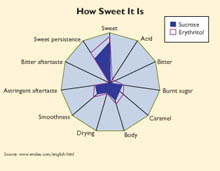
Cargill's (Blair, Neb.) commercial version of erythritol, Eridex[tm], can be used to enhance the inadequacies of other sweeteners in low-carb and no-sugar-added foods. Many polyols, for instance, can contribute to digestive intolerance. Therefore, they are not often used to sweeten diet drinks, which typically are consumed in large quantities.
While fructose, sucrose and glucose are actively transported, rapidly digested and absorbed, most of the sugar alcohols are transported into the gut, through passive diffusions, which are much slower and incomplete. The fraction that is not absorbed is sent to the lower gut, where it can cause discomfort. Erythritol, on the other hand, is absorbed but not metabolized at all, and 90%-95% is excreted through the kidney. Research shows that erythritol has the highest digestive tolerance of all sugar alcohols.
Erythritol's sweetness is 60%-70% relative to sucrose. In addition, erythritol masks the lingering aftertaste of intense sweeteners like aspartame, sucralose and acesulfame K, which provide sweetness, but no bulk. “Diet beverages that use intense sweeteners lack the mouthfeel on the palate that is normally perceived with sugar,” says Ravi Nana, technical service specialist on polyol applications at Cargill. Erythritol synergizes nicely with these to promote a smoother mouthfeel and body perception in reduced-calorie, aqueous solutions.
“All polyols are carbohydrates, but they are slow-digestible carbohydrates, as opposed to normal sugars,” explains Nana. “Eridex is a fine addition to low-carb, low-sugar baked and sweet goods. Also, Eridex does not contribute at all to the glycemic index,” he adds.
As with xylitol, erythritol has a high negative heat of solution (-43Kcal/g), causing an endothermic cooling effect that is typical of confections like mint chewing gums and throat lozenges. To some extent, this cooling effect can be minimized by adding polydextrose or inulin (which has a positive heat of solution), says Nana.
Since it is a low molecular weight sugar alcohol, it has influence in lowering the water activity of food, and its high osmotic pressure leads to an increased preservative effect and extended product shelflife. “Moreover, low molecular weight also will help in lowering the freezing point depression in frozen products,” he says.
Like other polyols, erythritol has no reducing group and, therefore, no Maillard reaction. “Eridex is low in solubility and crystallizes rapidly, making it ideal for fudge and fondant,” says Nana. Erythritol crystals melt at 121°C to form a colorless and transparent non-viscous melt. When an erythritol melt cools down, the crystallization starts at 43°C. Erythritol forms anhydrous crystals without off-tastes or odors. “It crystallizes rapidly under static conditions,” observes Nana. The powder has a transparent white, brilliant appearance that dissolves in water to give a colorless, non-viscous and sweet-tasting solution.
Polyols are not fermented by oral bacteria and, therefore, are considered non-cariogenic. Some research has shown that erythritol helps reduce the presence of oral bacteria capable of fermenting carbohydrates and harming dental enamel.
For more information:
Cargill Food and Pharma Specialties, Ravi Nana
319-399-2111, Ravi_nana@cargill.com, www.eridex.com


